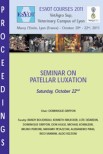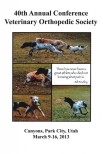Objective: To describe percutaneous fluoroscopy-guided placement of self-drilling, self-tapping, 3.0 mm cannulated headless compression screws (HCS) for surgical reduction of sacroiliac luxation (SIL) in cats, and to document clinical outcome.
Materials and methods: Medical records of cats with SIL, managed by percutaneous fluoroscopy-guided placement of a 3.0 mm HCS, were reviewed. Short-term outcome was assessed by clinical examination and radiographs. Long-term outcome was assessed using an owner questionnaire.
Results: A total of 14 cats, with 17 SIL (11 unilateral and 3 bilateral), were included. Mean postoperative sacroiliac joint reduction was 85%, median sacral purchase was 63% for unilateral and 38% for bilateral HCS, and pelvic canal diameter ratio and hemipelvic canal width ratio were satisfactory in all cases. At follow-up, all cats exhibited satisfactory clinical improvement. Radiographic assessment revealed no implant-related complications of the unilateral HCS; however, screw loosening was observed in 3/6 of bilateral HCS. Owner satisfaction was good, with 10/11 of owners being very satisfied and 1/11 being satisfied.
Clinical significance: Percutaneous fluoroscopy-guided placement of a 3.0 mm HCS is a safe and effective method for unilateral surgical reduction of SIL in cats. Further studies are needed to establish the most appropriate procedure to treat bilateral SIL.









